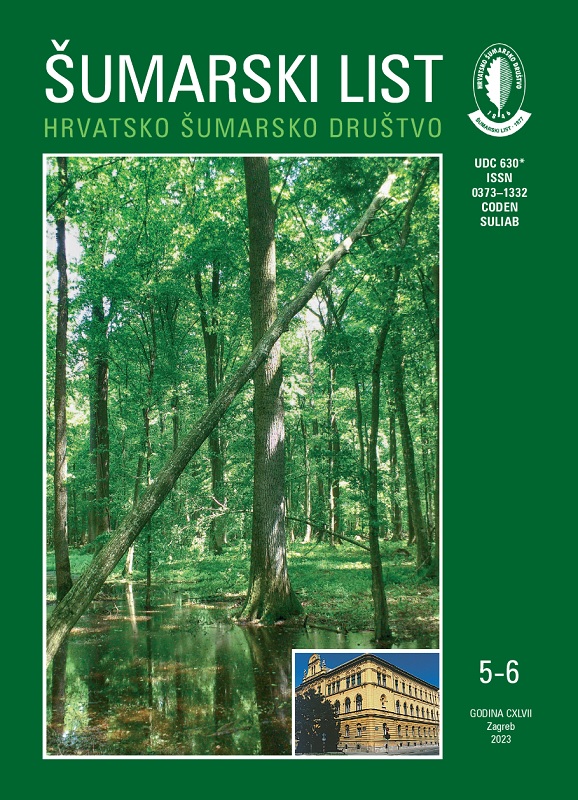
broj: 5-6/2023
pdf (7,81 MB) |
|
||||||||||||||
| RIJEČ UREDNIŠTVA | ||
| Uredništvo | ||
| University of Zagreb, Faculty of forestry and wood technology – provider of education in forestry and wood technology pdf HR EN | 205 | |
| IZVORNI ZNANSTVENI ČLANCI | ||
| Hazan Alkan Akinci,Funda Erşen Bak | UDK 630* 622 + 564 (001) https://doi.org/10.31298/sl.147.5-6.1 | |
| Pojava ženki velikog smrekinog likotoča Dendroctonus micans (Kugelann, 1794) na vitalnim stablima kavkaske smreke u Artvinu, Turska pdf HR EN | 207 | |
| Arzu Ergül Bozkurt, Kamil Coşkunçelebi, Salih Terziog˘lu | UDK 630* 811 (001) https://doi.org/19.31298/sl.147.5-6.2 | |
| Variation in needle anatomy of scots pine (Pinus sylvestris L.) populations according to habitat and altitudinal zones in Türkiye pdf HR EN | 215 | |
| Velisav Karaklić, Zoran Galić, Miljan Samardžić, Lazar Kesić, Saša Orlović, Martina Zorić | UDK 630* 114.6 (001) https://doi.org/110.31298/sl.147.5-6.3 | |
| Carbon dioxide (CO2) emissions from soils during the regeneration of pedunculate oak (Quercus robur L.) stand in the summer period pdf HR EN | 227 | |
| PRETHODNO PRIOPĆENJE | ||
| Mario Šporčić, David Mijoč, Matija Bakarić, Zdravko Pandur, Marin Bačić, Matija Landekić | UDK 630* 969 https://doi.org/10.31298/sl.147.5-6.4 | |
| The challenge of recruiting forestry workforce in Europe and worldwide pdf HR EN | 239 | |
| Summary We can define workforce as the totality of human physical and mental abilities that is used to produce use values of any kind. The scope or size of the workforce depends on the total number of inhabitants and their numerous structural characteristics. As an economically active part of the population, it is the most significant factor in the production process in all types of society, regardless of the changes that took place during historical development in its role as the initiator and bearer of the production process. Work in forestry includes all human activities that are necessary for the performance of planned forestry tasks, in order to achieve benefits from the forest and forestland. In accordance with this, forestry workers, i.e. people with the necessary knowledge, skills and abilities, along with the appropriate work means and the subject of work, represent a fundamental factor in forestry production. Professionally trained, responsible, conscientious and motivated forestry workers have a crucial role in achieving successful production and business results and are an inseparable component in the modern, generally accepted paradigm of sustainable forest management. Forestry work, especially wood harvesting, is a high-risk, physically intensive and professionally demanding activity, which requires a qualified and sustainable workforce. However, today in a world of constant changes, forestry is faced with the challenge of securing the necessary workforce. The lack of forestry workers is becoming an increasingly frequent problem in European and global forestry, and the reason for this are different demographic, economic, technological and political processes, as well as the specifics of the sector itself. Therefore, in addition to the general characteristics of forestry work, the paper presents some indicators of the status and position of the forestry workforce in Europe and the world. Special attention is paid to current issues and problems in obtaining and securing the necessary forestry workforce (shortage of workers, lack of interest among young people, aging of the existing workforce, forestry entrepreneurs, informal employment, etc.) and to certain tools and instruments important for successful recruitment and retention of forestry workers (understanding of their motivation, work compensation, education and training of workers, new technologies, etc.). It is emphasized that the discipline of human resources management should gain a much more prominent place in forest management and become the main task of forestry managers in efforts to solve the issue of workforce sustainability. Equally, the forestry sector should adapt its policies and activities to global processes affecting the workforce, especially in terms of social, economic and other trends, through the development of new skills and technologies, the establishment of flexible organizational structures, reorganization of work, adaptive forms of employment, introduction of “green jobs” and other procedures that can contribute to sustainability and competitiveness of the sector itself. The purpose of the paper includes provision of basis that can be an important contribution in improving the condition and sustainability of the workforce in forestry. Key words: forestry; forestry work; worker recruitment and retention; workforce sustainability | ||
| PREGLEDNI ČLANCI | ||
| Matija Bakarić, Matija Landekić, Mario Šporčić | UDK 630* 907.1 + 934 https://doi.org/10.31298/sl.147.5-6.5 | |
| Revenue structure of public institutions for the management of protected areas in Republic of Croatia pdf HR EN | 251 | |
| David Janeš, Ivica Papa, Sandi Matijašević, Ivan Žarković, Mihael Lovrinčević, Andreja Đuka | UDK 630* 686+463 https://doi.org/10.31298/sl.147.5-6.6 | |
| Useful GIS tools in defining forest accessibility pdf HR EN | 261 | |
| Marija Popović, Hristo Mihaylov, Nikola Mihajlović, Zoran Popović | UDK 630* 156 https://doi.org/10.31298/sl.147.5-6.7 | |
| Incomes of roe deer management in the hunting grounds of Central Serbia pdf HR EN | 275 | |


